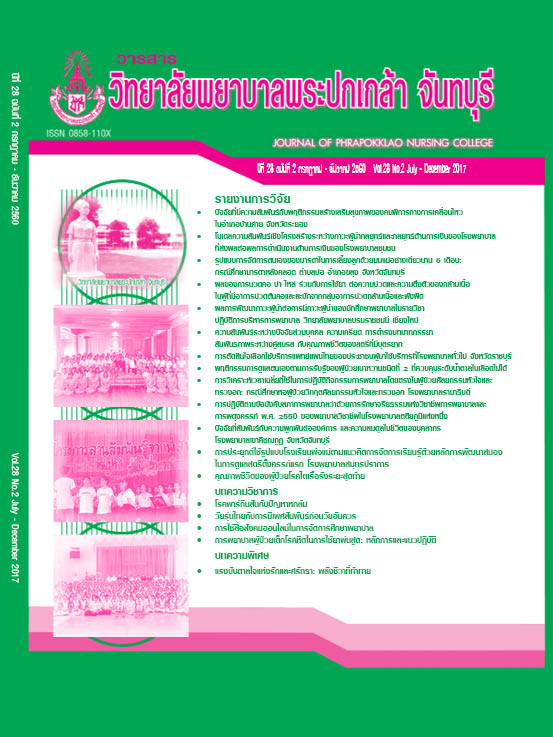Fall in Parkinson’s Disease
Keywords:
-Abstract
-
References
ปวันรัตน์ ศรีคำ. (2557). ปัจจัยทำนายการหกล้มในผู้สูงอายุโรคพาร์กินสัน (วิทยานิพนธ์ปริญญามหาบัณฑิต). กรุงเทพฯ: จุฬาลงกรณ์มหาวิทยาลัย.
มูลนิธิสถาบันวิจัยและพัฒนาผู้สูงอายุไทย. (2558). ยากันล้ม คู่มือป้องกันการหกล้มในผู้สูงอายุ. กรุงเทพฯ: ผู้แต่ง.
รุ่งโรจน์ พิทยศิริ. (2559). พาร์กินสัน เทรนด์โรคใหม่ของวัยทำงาน วิจัย “ไม้เท้าเลเซอร์” ช่วยการเดิน. สืบค้น วันที่ 25 ตุลาคม 2560, จาก https://www.thairath.co.th/content/613032
สลิล ศิริอุดมภาส. (2559). โรคพาร์กินสัน. สืบค้น วันที่ 25 ตุลาคม 2560, จาก http://haamor.com/th/พาร์กินสัน/
สำนักนโยบายและยุทธศาสตร์ กระทรวงสาธารณสุข. (2556). สถิติข้อมูลภาวะสุขภาพผู้สูงอายุ. นนทบุรี: ผู้แต่ง.
Allen, N. E., Schwarzel, A. K., & Canning, C. G. (2013). Recurrent falls in Parkinson’s disease: A systematic review. Parkinson’s disease. Retrieved July 25, 2017, from https://www.ncbi.nlm.nih.gov/pubmed/23533953
Centers for Disease Control and Prevention. (2010). Guideline for preventing falls. Web-based preventing falls. Retrieved November 15, 2017, from https://orthoinfo.aaos.org/falls/
Falce, A. (2015). Keeping step with Parkinson’s: Balance, posture and gait. Retrieved July 25, 2017, from https://www.michaeljfox.org/foundation/news-detail.php?podcast-keeping-step-with-parkinson-balance-posture-and-gait
Fortinsky, R. H., et al. (2004). Fall-risk assessment and management in clinical practice: Views from healthcare providers. Journal of the American Geriatrics Society, 52(9), 1522-1526.
Hardy, J. (2008). Multiple system atrophy: Pathophysiology, treatment and nursing care. Nursing Standard, 22(22), 50-56. Retrieved July 25, 2017, from https://www.ncbi.nlm.nih.gov/pubmed/18333558
Health MThai Team. (2558). ผู้สูงอายุลื่นล้ม นำไปสู่พิการ-เสียชีวิต ความเสี่ยงอันดับ 2 รองจากอุบัติเหตุท้องถนน. Retrieved July 25, 2017, from https://health.mthai.com/howto/health-care/10882.html
Lindholm, B., Hagell, P., Hansson, O., & Nilsson, M. H. (2014). Factors associated with fear of falling in people with Parkinson’s disease. BMC Neurology, 14, 19. Retrieved July 25, 2017, from https://www.ncbi.nlm.nih.gov/pubmed/24456482
McCabe, M. P., Roberts, C., & Firth, L. (2008). Work and recreational changes among people with neurological illness and their caregivers. Journal of Disability and Rehabilitation, 30(8), 600-610. Retrieved July 25, 2017, from https://www.ncbi.nlm.nih.gov/pubmed/17852325
Michałowska, M., Fiszer, U., Krygowska-Wajs, A., & Owczarek, K. (2005). Fall in Parkinson’s disease. Cause and impact on patients’ quality of life. Functional Neurology, 20(4), 163-168.
Playfer, J. R. (2001). Falls and Parkinson’s disease. Age and Ageing, 30, 3-4.
Sattin, R. W., Rodriguez, J. G., DeVito, C. A., & Wingo, P. A. (2000). Home environmental hazards and the risk of fall injury events among community-dwelling older persons. Study to assess falls among the elderly (SAFE) group. Journal of the American Geriatrics Society, 46(6), 669-676.
Thomas, S., & Sweetnam, C. (2002). Parkinson’s disease caring for the carers. Primary Health Care, 12(4), 27-31.
Tuite, P., Thomas, C., Ruekert, L., & Fernandez, H. (2009). Parkinson’s disease: A guide to patient Care. New York: Springer Publishing Company.
Downloads
Published
How to Cite
Issue
Section
License
Copyright (c) 2017 Journal of Phrapokklao Nursing College

This work is licensed under a Creative Commons Attribution-NonCommercial-NoDerivatives 4.0 International License.
เนื้อความ ข้อมูล และรายการอ้างอิงที่ผู้เขียนใช้ในการเขียนบทความเพื่อลงตีพิมพ์ในวารสารวิทยาลัยพยาบาลพระปกเกล้า จันทบุรี ถือเป็นความคิดเห็นและความรับผิดชอบของผู้เขียน คณะผู้จัดทำวารสารไม่จำเป็นต้องเห็นพ้องด้วยหรือร่วมรับผิดชอบ
บทความที่ได้รับการลงตีพิมพ์ในวารสารวิทยาลัยพยาบาลพระปกเกล้า จันทบุรี ถือเป็นลิขสิทธิ์ของวารสารวิทยาลัยพยาบาลพระปกเกล้า จันทบุรี หากหน่วยงานหรือบุคคลใดต้องการนำส่วนหนึ่งหรือทั้งหมดของบทความไปเผยแพร่ต่อเพื่อวัตถุประสงค์ใด ๆ จะต้องได้รับอนุญาตจากบรรณาธิการวารสารก่อน



